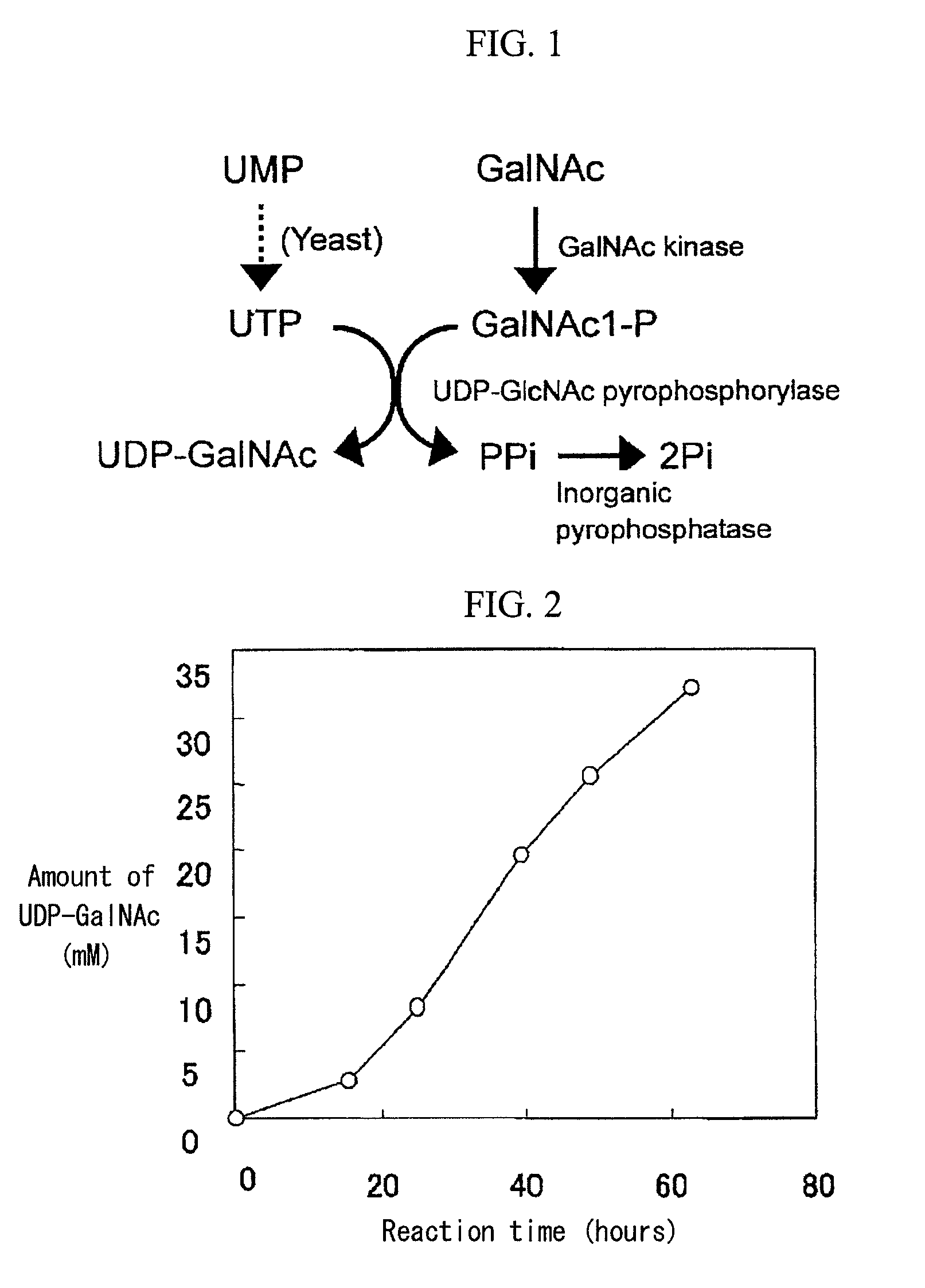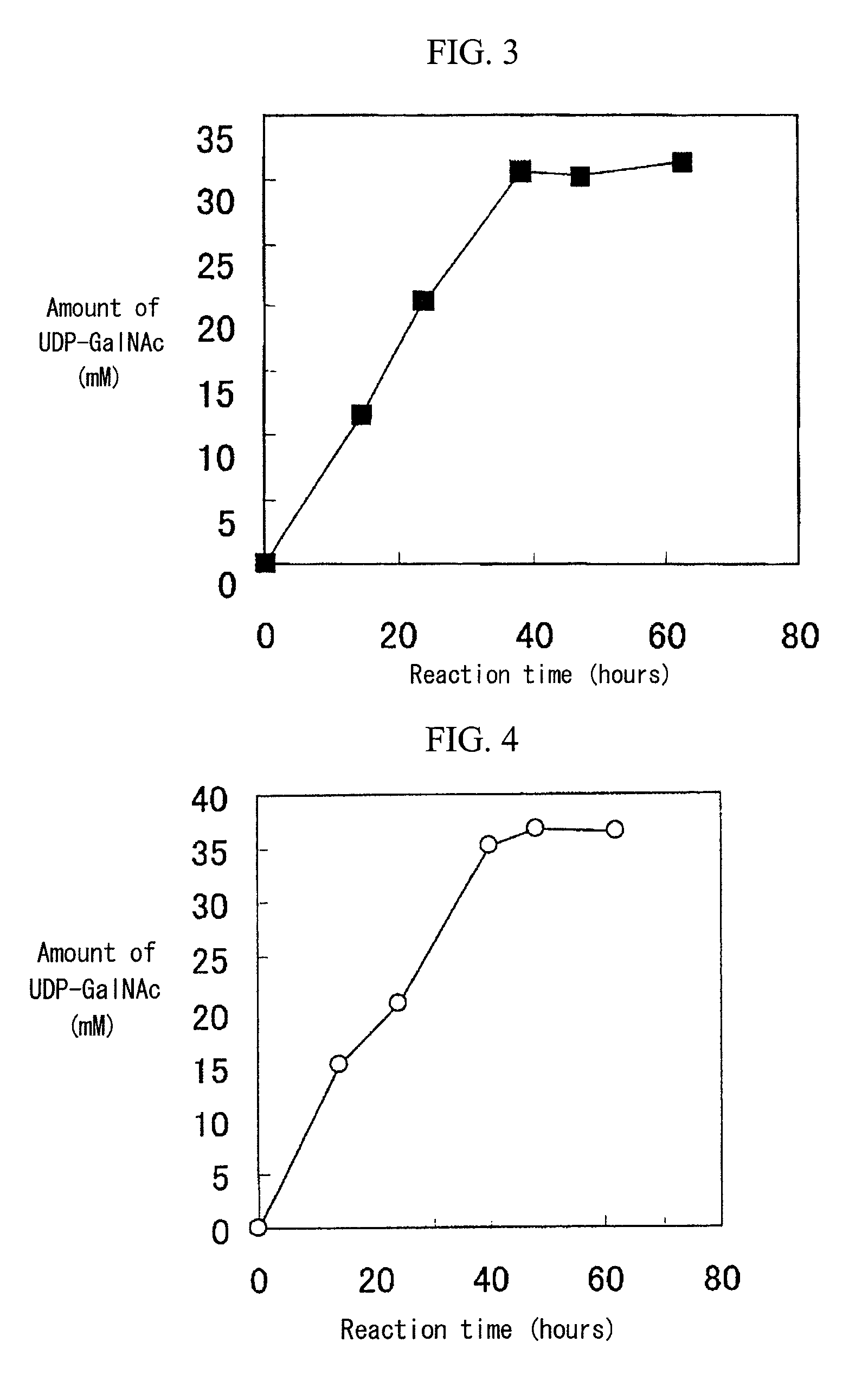Method of producing uridine 5′-diphospho-N-acetylgalactosamine
a technology of diphosphonacetylgalactosamine and uridine, which is applied in the direction of enzymology, organic chemistry, transferases, etc., can solve the problems of low overall reaction yield, high cost, and use of sugar donors, so as to facilitate the preparation of enzymes, facilitate the effect of synthesis, and easy isolation and purification
- Summary
- Abstract
- Description
- Claims
- Application Information
AI Technical Summary
Benefits of technology
Problems solved by technology
Method used
Image
Examples
example 1
(1) Cloning of GALK2 Gene Encoding Human Kidney-Derived N-Acetylgalactosamine Kinase
[0059]By using a human kidney-derived cDNA library (available from Clontech) as a template, the following two primer DNAs were synthesized through a customary method, and human kidney GALK2 gene (Submitted to NCBI, Accession No. NM 002044) was amplified through PCR.
[0060]Primer (A): 5′-CGGGGATCCATGGCTACAGAGAGCCCTGCT-3′
[0061]Primer (B): 5′-TACGTCGACTTAGGCCTCAAGCAAAACCAA-3′
[0062]PCR amplification of the GALK2 gene was performed by means of a DNA Thermal Cycler Dice (product of Takara Bio Inc.) through 30 cycles of treatment, each cycle consisting of the steps of thermal denaturation (94° C., one minute), annealing (59° C., one minute), and elongation (72° C., two minutes), of a reaction mixture (1001 μL) containing 50 mM potassium chloride, 10 mM Tris-HCl (pH 8.3), 1.5 mM magnesium chloride, 0.001% gelatin, 0.2 mM dATP, 0.2 mM dGTP, 0.2 mM dCTP, 0.2 mM dTTP, template DNA (0.1 ng), primer DNAs (A) and (...
example 2
(1) Synthesis of UDP-GalNAc by Use of Human N-Acetylgalactosamine Kinase and Escherichia coli UDP-GlcNAc Pyrophosphorylase
[0075]The N-acetylgalactosamine kinase solution (0.094 units) and UDP-GlcNAc pyrophosphorylase solution (4.4 units) prepared above in Example 1, each having a predetermined activity, and inorganic pyrophosphatase (product of Sigma, 0.5 units) were added to a solution (0.2 mL) containing 100 mM Tris-HCl buffer (pH 7.5), 10 mM magnesium chloride, 5 mM 5′-UTP.3Na, 5 mM GalNAc, 5 mM 5′-ATP.3Na, and 5 mM sodium fluoride, followed by reaction at 37° C.
[0076]In the middle of the reaction, an appropriate amount of the reaction mixture was collected, and then boiled for five minutes, followed by centrifugation. The resultant supernatant was subjected to HPLC analysis. Analysis of the reaction mixture four hours after initiation of the reaction showed that 3.2 mM UDP-GalNAc was synthesized in the presence of N-acetylgalactosamine kinase, UDP-GlcNAc pyrophosphorylase, and i...
example 3
(1) Synthesis of UDP-GalNAc by Use of Dry Yeast, Human N-Acetylgalactosamine Kinase, and Escherichia coli UDP-GlcNAc Pyrophosphorylase
[0077]The recombinant enzyme prepared in Example 1 (N-acetylgalactosamine kinase: 0.32 units, UDP-GlcNAc pyrophosphorylase: 10.4 units) was added to a solution (1 mL) containing 200 mM glucose, 50 mM GalNAc, 50 mM UMP, 200 mM potassium phosphate (pH 8.0), 20 mM magnesium chloride, and 3% (w / v) dry baker's yeast (Oriental Yeast Co., Ltd.), followed by reaction at 26° C. with stirring at a speed of 300 rpm. A 2M glucose solution (0.1 mL) was added to the reaction mixture 16 hours, 24 hours, 40 hours, and 48 hours after initiation of the reaction. FIG. 2 shows the results of time-course analysis of the reaction mixture. The amount of accumulated UDP-GalNAc reached 32 mM through 49-hour reaction.
PUM
| Property | Measurement | Unit |
|---|---|---|
| pH | aaaaa | aaaaa |
| concentration | aaaaa | aaaaa |
| pH | aaaaa | aaaaa |
Abstract
Description
Claims
Application Information
 Login to View More
Login to View More - R&D
- Intellectual Property
- Life Sciences
- Materials
- Tech Scout
- Unparalleled Data Quality
- Higher Quality Content
- 60% Fewer Hallucinations
Browse by: Latest US Patents, China's latest patents, Technical Efficacy Thesaurus, Application Domain, Technology Topic, Popular Technical Reports.
© 2025 PatSnap. All rights reserved.Legal|Privacy policy|Modern Slavery Act Transparency Statement|Sitemap|About US| Contact US: help@patsnap.com



